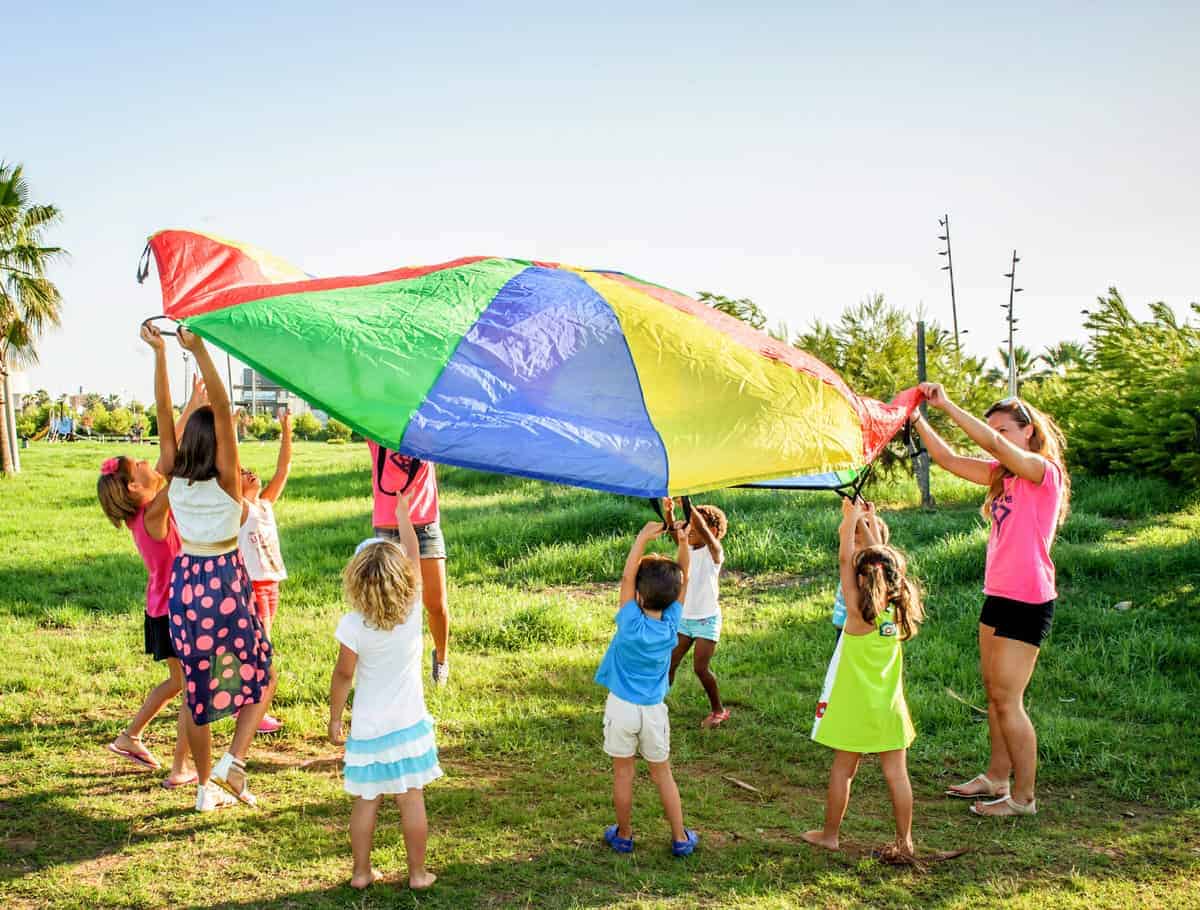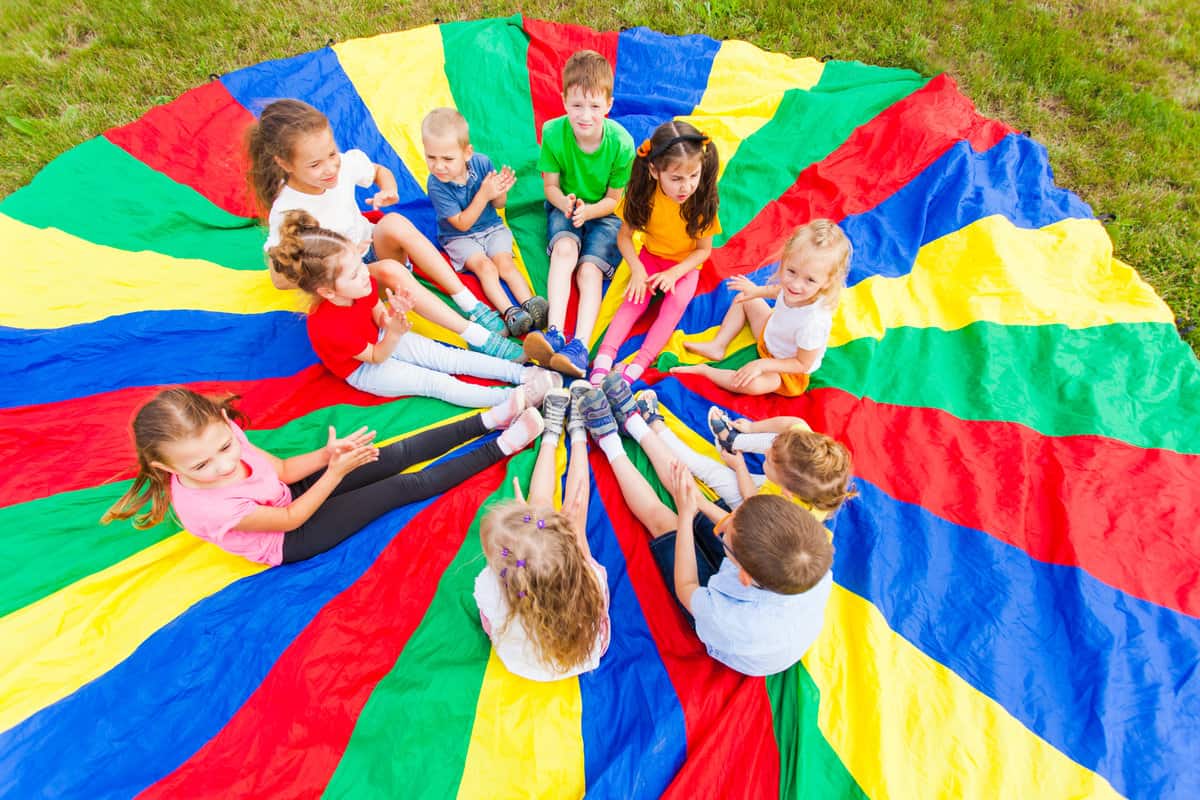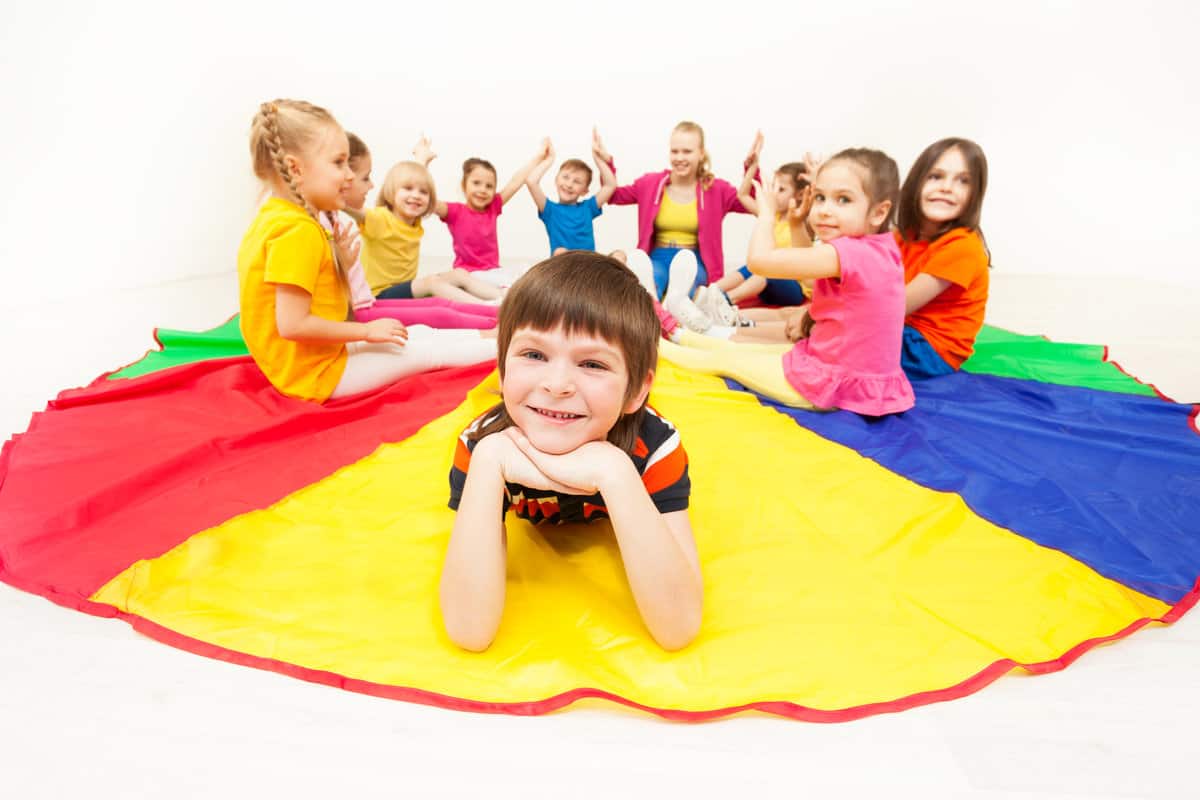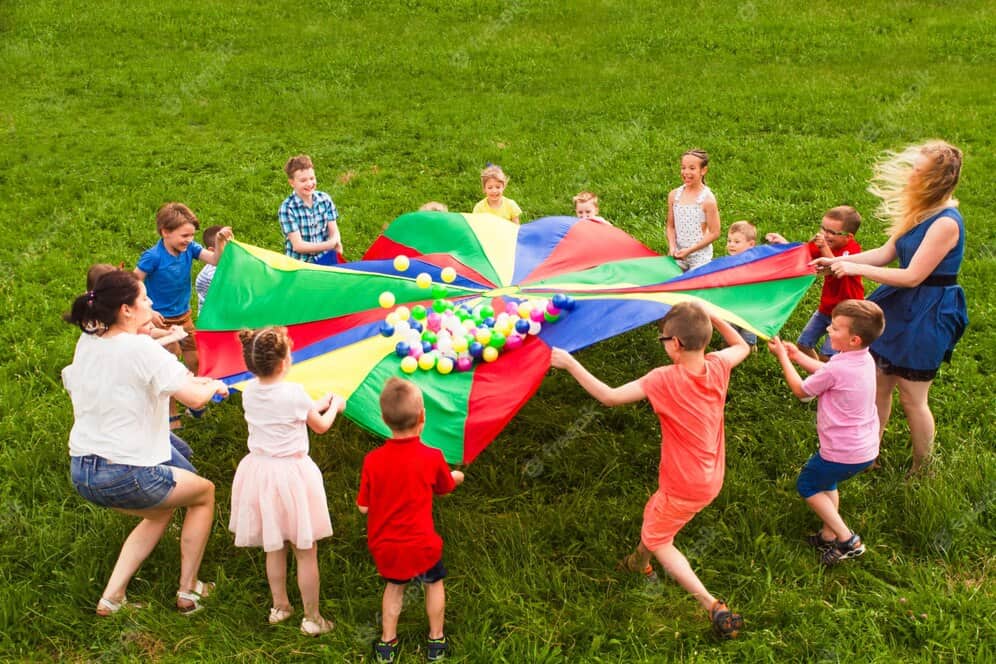The present article aims to provide a variety of parachute games to be carried out both in the school environment and in leisure and free time activities.
What is the parachute in physical education?
The parachute in physical education is a material resource that gives rise to various recreational and playful approaches.
The parachute is made up of a large, very solid synthetic fabric, usually identified by 4 colors (yellow, red, green, and blue) that offers the possibility of carrying out different types of cooperative activities that favor the inclusion of all students in physical education classes (1).
In physical education, the parachute is a pedagogical tool consisting of a large circular nylon or polyester canvas, with handles distributed evenly along its edge.
This generally colorful canvas is used to perform a variety of games and activities that involve participants holding it by the handles and moving it up and down, creating impressive visual effects and cooperative play dynamics.
The activities designed around the parachute can range from simple warm-up exercises, such as making waves or creating air bubbles, to more complex games that involve coordination, strategy, and teamwork, such as moving objects on the parachute without letting them fall or coordinating movements so that the “inflated” parachute moves in a certain direction.
One of the most notable aspects of the parachute in physical education is its ability to promote cooperation and inclusion. Since parachute games require participants to work together to achieve a common goal, they foster communication, mutual respect, and solidarity among students.
In addition to social and cooperative benefits, the use of the parachute in physical education also offers significant physical benefits.
Activities can be designed to improve motor coordination, muscle strength, cardiovascular endurance, and flexibility. The dynamism of parachute games ensures that participants remain active and engaged, turning exercise into a fun and stimulating experience.
How can the parachute be used in physical education?
The uses of the parachute in physical education can be very varied, highlighting its use in cooperative games, group dynamics, or as part of the field of body expression, being an essential element for working on transversal elements (solidarity, tolerance, coeducation, etc.), as well as for the approach of interdisciplinary projects with other areas and/or subjects (1, 2).
In fact, there is the possibility of self-constructing the parachute with recycled materials, thus also working on group cooperation and sustainability.
In this video from Antonio Méndez Giménez’s channel, the way to self-construct the parachute using plastic bags is explained.
What benefits does the parachute have in physical education?
Among the benefits that the parachute game brings to physical education, the following could be mentioned (1, 2):
- It favors the feeling of belonging to the group, being an essential element for working on cooperation.
- It offers a diversity of possibilities, bringing dynamism to physical education sessions.
- It provides an extra motivation for students due to its particular characteristics in terms of colorfulness, dimensions, and movements.
- It can be used at any age, which gives the possibility of proposing intergenerational activities.
- It fosters the creativity of students regarding the different uses of the parachute.
Parachute games in physical education provide considerable benefits beyond simple exercise, positively impacting various areas of human development.
By using the parachute, participants significantly improve their motor coordination and muscle strength. Manipulating the parachute requires a combination of movements that help not only develop hand-eye coordination but also strengthen the muscles of the arms, torso, and improve overall body coordination. These aspects are fundamental both for children in growth stages and for adults seeking to maintain or improve their physical condition.
In addition to physical benefits, parachute games are exceptional for fostering cooperation and teamwork. The nature of these activities requires participants to collaborate closely to achieve common goals, thus promoting teamwork and cooperation skills.
This collaboration results in a valuable lesson on the importance of working together, essential skills in practically all aspects of life.
On the social and emotional level, participating in parachute games provides an excellent opportunity for the development of social skills.
The interaction that arises in these games allows participants to practice and improve communication, negotiation, and respect for others, fundamental for the comprehensive development of any individual.
Finally, the impact of parachute games on stimulating creativity and imagination cannot be underestimated.
Parachute games
Below is a decalogue of parachute games for physical education sessions (1, 2, 3, 4).
Parachute game 1: color basket
This is a parachute game where all participants stand around it, assigning each person a color: red, green, yellow, or blue.
The objective of the game is to get several people to exchange their positions around the parachute by crossing under the fabric.
The teacher starts the game by saying: “One, two… (and one of the four colors)!” At that moment, the group inflates the parachute, and the participants whose color matches the one named change positions, crossing under the parachute fabric, avoiding it touching them.
- Variants: Two or three colors can be named at once, so that all people linked to the named color change places under the parachute. Also, there is the possibility of mentioning two colors, so that those of the first color change places under the parachute and those of the second do so around it.
Another possibility, for any of the previous proposals, would be that before making the position change, they must pass under the legs of one of the classmates holding the parachute.
Parachute game 2: the names
In this parachute game, the fabric is stretched, and a ball is placed on top. Someone says the name of a classmate, and they have to try to make the ball fall towards that person.
This game can serve as an introduction dynamic when participants do not know each other beforehand, so they can learn the names of the other children in a fun way.
Parachute game 3: tossing objects in groups
In this parachute game, the group is divided into two, adopting the name of a color, one group can be green, and the other is identified with a different color, for example, red.
The whole group then stands around the parachute, interspersing the two colors. The objective of the game is to toss different objects, placed on the parachute fabric (balls, indiacas, frisbees, etc.), as long as possible. The group starts the activity by shaking the fabric, seeking to make the different objects rise as much as possible to catch them on their fall with the parachute.
The teacher can say: “Reds (or greens), out!”, so that all players identified with the mentioned color leave the parachute fabric and are in charge of collecting the objects that fell off the parachute, returning them to it. When the teacher says: “Everyone in!”, everyone returns to the parachute.
The game ends when there are no objects left on the parachute to toss.
- Variants: To increase the difficulty of the game, a rule can be established that a player with an object cannot move their feet. In this way, they must throw the object to the parachute from where they pick it up or pass it to a teammate located closer to it.
Parachute game 4. Land, sea, and air
A very fun parachute game is undoubtedly “land, sea, and air”. In this game, all participants stand around the parachute to perform the different actions indicated based on what the facilitator says:
- When “air” is said, participants will raise the parachute upwards.
- When “land” is said, they will lower it to the ground.
- When “sea” is said, they will shake the parachute.
As variants, other words and movements can be included, for example, when “tornado” is said, everyone turns clockwise, and when “earthquake” is said, everyone falls to the ground along with the parachute.
Parachute game 5. The pirate ship
The whole class stands around the parachute on whose fabric two balls of different colors are placed. It is assumed that one of the balls is our ship, and the other is a pirate ship.
[article ids=”65275″] The objective of the game is to take our ship to the island (central hole of the parachute), if possible before the pirate ship does.
If our ship reaches the island before the pirate, the group scores two points (corresponding to two extra rounds). On the other hand, if the pirate arrives first and then ours, the group scores one point (corresponding to one extra round).
If either of the two ships sinks, the group loses the round they were playing. The game begins by granting the class a certain number of rounds and ends when the group has no rounds left to continue playing.
Parachute game 6. Climb the mountain
This is a cooperative parachute game. It consists of everyone working together to create a “mountain” using the parachute and then, in pairs, going out and trying to climb the mountain (over the parachute) while the rest of the participants keep the mountain steady, that is, lowering the parachute to the ground.
In the following video, this game is exemplified (3).
Parachute game 7: the lifeguard
Three roles are assigned to the students:
- Shark: the person who assumes this role (only one person) will be in charge of getting under the parachute.
- Swimmers: these are the students who are sitting and slightly moving the parachute so that the shark’s location is unknown.
- Lifeguard: this is the student who is outside the parachute.
At the teacher’s signal, the shark will start grabbing the swimmers by the ankles and dragging them into the sea (under the parachute). When the swimmer feels attacked by the shark, they will shout “lifeguard!” so that the lifeguard quickly approaches and holds them to prevent them from being swallowed by the shark.
Swimmers who are caught by the shark become sharks and attack more people.
- Variants: more lifeguards can be added to make the game last longer, as well as increasing the number of participants playing the role of the shark.
Parachute game 8: the tower
This parachute game consists of each participant standing on a brick at their feet (they must be of different colors).
The teacher says a color, and those with the brick of that color will have to enter the parachute and place the bricks to build a tower and return to their place before the parachute touches them.
Parachute game 9: the cat and the mouse
This is the classic game of “cat and mouse,” but in this case using the parachute. In this parachute game, all participants stand around it, and the roles of cat and mouse are assigned to two people.
To start the game, the participants around the parachute shout “mouse” for it to go under the parachute.
Then, they shout “cat,” for it to try to catch the mouse by moving on all fours. A time limit is set for the cat to catch the mouse, and then the roles are exchanged.
Parachute game 10: fruit salad
In this parachute game, participants stand around it. The teacher assigns fruit names to each student (apple, grape, pear, berry, etc.), ensuring that each fruit is assigned to two players.
Participants move the parachute up and down.
The teacher says the names of the fruits, and when their fruit is called, the students cross under the parachute to exchange their positions (4).
- Variants: a time limit can be set to make the player exchange as quickly as possible, and they can even move in different ways under the parachute (crawling, hopping on one foot, jumping with both feet, etc.)
In this video, you can find some of the parachute games previously explained, as well as others that can be of great application for physical education classes.
Conclusion
In summary, the parachute in physical education is a multifunctional educational tool that promotes the physical, social, and emotional development of students through play and collaborative physical activity.
This article has presented a total of 10 parachute games that can be applicable to any age and at any educational stage, making the pertinent modifications and adaptations.
Undoubtedly, the parachute is presented as an indispensable tool for the comprehensive development of children and adolescents, which will provide moments of joy, fun, enjoyment, and socialization among them.
Bibliographic references
- Monge, M., & Meneses, M. (2005). The use of the parachute in recreational activities, as a means to reinforce the value of cooperation. Revista Educación, 29(1), 79-89.
- French, R., & Horvat, M. (2007). Parachute activities (Vol. 36). Editorial Paidotribo.
- Cleaver, S. (2023). 37 Parachute Games That Kids Will Really Grab Onto. Retrieved on 27/03/2024.
- The PE Specialist. 10 Awesome Parachute Activities for PE Class. Retrieved on 20/03/2024.




